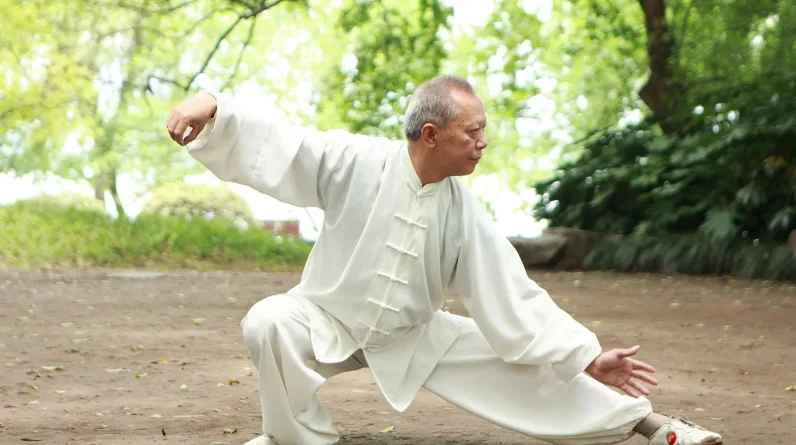
The Moving Meditation: A Tai Chi Journey Begins with One Step
What comes to mind when you mention Tai Chi Journey? Do you envision Kung Fu Panda, Bruce Lee, or perhaps elderly individuals gracefully performing slow movements in the local park during the morning? What exactly is Tai Chi and what purpose does it serve? How challenging is it to acquire the necessary skills?
As our lives become busier and more complicated, an increasing number of people find meditation a great tool to cope with the day to day stresses such as work, finance and relationships. Tai Chi, as a martial art, incorporates many of the foundations of meditation in its practice. Tai Chi is therefore commonly described as “moving meditation.”
What is Tai Chi ?
Tai Chi, also known as Tai Chi Chuan or Taijiquan, is an ancient Chinese martial art that has evolved into a popular form of exercise and meditation. It originated in China over 400 years ago and is characterized by slow, flowing movements combined with deep breathing and mental focus.
Tai Chi is often practiced for its health benefits, promoting balance, flexibility, strength, and relaxation. It involves a series of continuous, gentle movements that are performed in a slow and controlled manner. The movements are typically circular and smooth, emphasizing proper body alignment and posture.
The practice of Tai Chi is rooted in the concept of Yin and Yang, which represents the balance and harmony of opposing forces in the universe. Practitioners seek to cultivate a state of balance and flow, both physically and mentally, through the practice of Tai Chi.
In addition to its physical benefits, Tai Chi is also considered a moving meditation. The slow and deliberate movements, combined with focused attention, promote a sense of calmness and inner peace. Many people find Tai Chi to be a valuable tool for stress reduction and improving mental well-being.
Tai Chi can be practiced by people of all ages and fitness levels. It does not require any special equipment and can be performed indoors or outdoors. It is often taught in group classes or workshops led by experienced instructors who guide students through the various movements and principles of Tai Chi.
Overall, Tai Chi offers a holistic approach to health and well-being, combining physical exercise, mental relaxation, and meditation in a single practice. It has gained popularity worldwide for its numerous benefits and is enjoyed by millions of people as a way to improve both body and mind.
What is the difference between Tai Chi and Qigong?
Tai Chi and Qigong are both ancient Chinese practices that promote health, vitality, and spiritual development. While they have some similarities, there are distinct differences between the two:
- Origin and Purpose:
- Tai Chi: Tai Chi, also known as Tai Chi Chuan, originated as a martial art in ancient China. It combines martial arts movements with deep breathing and relaxation techniques. Over time, Tai Chi evolved to become a practice focused on promoting physical health, balance, and mindfulness.
- Qigong: Qigong, also spelled as Chi Kung, has its roots in traditional Chinese medicine and philosophy. It encompasses a wide range of exercises and techniques aimed at cultivating and balancing Qi (vital energy) within the body. Qigong is primarily focused on energy cultivation, promoting overall well-being, and harmonizing the body, mind, and spirit.
- Movement and Form:
- Tai Chi: Tai Chi consists of a series of slow and continuous flowing movements that are performed in a specific sequence, often referred to as a form or routine. These movements are characterized by smooth transitions, coordinated body alignment, and weight shifting. Tai Chi forms typically emphasize balance, flexibility, and controlled movement.
- Qigong: Qigong exercises can involve a variety of movements, including slow and flowing movements similar to Tai Chi, as well as stationary postures, gentle stretches, and specific breathing techniques. Qigong exercises may be more focused on specific energetic pathways, internal organ systems, or individual exercises designed to cultivate and circulate Qi.
Martial Arts Element:
- Tai Chi: Tai Chi retains its martial arts roots, and some forms of Tai Chi still incorporate self-defense techniques. However, in contemporary practice, the martial aspect is often de-emphasized in favor of its health benefits.
- Qigong: Qigong does not have a direct martial arts component. While some Qigong exercises may have martial origins, they are primarily practiced for their health-enhancing and spiritual aspects.
- Purpose and Benefits:
- Tai Chi: Tai Chi promotes physical fitness, balance, flexibility, and coordination. It also enhances mental clarity, relaxation, and mindfulness. Regular practice of Tai Chi is believed to improve overall health, reduce stress, and increase vitality.
- Qigong: Qigong focuses on cultivating and balancing Qi, promoting health, vitality, and longevity. It aims to strengthen the body’s self-healing abilities, enhance energy flow, and harmonize the body, mind, and spirit. Qigong practice is believed to improve overall well-being, boost the immune system, reduce stress, and enhance mental clarity.
While Tai Chi and Qigong have their unique characteristics, there is also an overlap between the two practices. Some Tai Chi forms incorporate Qigong exercises, and many Qigong practices include Tai Chi-like movements. Both practices are often used in complementary ways to promote health and well-being.
What are the benefits of Tai Chi?
Tai Chi is a traditional Chinese martial art that combines graceful movements, meditation, and deep breathing techniques. It has been practiced for centuries and offers numerous benefits for physical, mental, and emotional well-being. Here are some of the key benefits of practicing Tai Chi:
Improved balance and flexibility: Tai Chi movements involve gentle weight shifting, coordinated body alignment, and controlled stepping. Regular practice can enhance balance and flexibility, reducing the risk of falls, especially in older adults.
Increased strength and stamina: Despite its gentle appearance, Tai Chi requires a certain level of strength and endurance. The slow and controlled movements help build muscle strength, particularly in the lower body, while improving overall stamina.
Stress reduction: Tai Chi incorporates deep breathing and mindfulness, promoting relaxation and reducing stress levels. The flowing movements and focused attention help calm the mind, relieve anxiety, and improve overall mental well-being.
Enhanced cognitive function: Research suggests that Tai Chi can have positive effects on cognitive function, including memory, attention, and cognitive flexibility. Regular practice may help improve cognitive abilities and protect against age-related cognitive decline.
Cardiovascular health:
While Tai Chi is a low-impact exercise, it can still provide cardiovascular benefits. The gentle aerobic nature of Tai Chi movements increases heart rate and improves circulation, which can contribute to cardiovascular health.
Pain management: Tai Chi has been shown to be effective in managing chronic pain conditions such as arthritis, fibromyalgia, and lower back pain. The slow, controlled movements help improve joint flexibility and reduce muscle tension, alleviating pain symptoms.
Better posture and body awareness: Tai Chi emphasizes proper body alignment, posture, and coordination. Regular practice can improve body awareness and alignment, promoting better posture and reducing the risk of musculoskeletal imbalances and injuries.
Social interaction and community: Tai Chi is often practiced in groups or classes, providing opportunities for social interaction and a sense of community. Engaging in regular group sessions can help combat feelings of isolation and enhance overall well-being.
Mind-body connection: Tai Chi cultivates a strong mind-body connection by encouraging practitioners to be fully present and aware of their body’s movements and sensations. This integration of mind and body can promote a sense of harmony, inner peace, and self-awareness.
Overall well-being: By combining physical exercise, meditation, and relaxation, Tai Chi promotes a holistic approach to well-being. Its gentle and accessible nature makes it suitable for people of all ages and fitness levels, offering a holistic practice that benefits the body, mind, and spirit.
Is it difficult to learn?
As the title says, a journey of Tai Chi begins with one step and one step at a time. I would recommend you to drop your goals, plans or expectations; feel your body’s movements and be aware of your breath and the connection between your breath and your movements. The forms are not important. What is important is that you give yourself the time and space to practice. Let’s start with separating your feet to shoulder distance apart. Raise both arms to shoulder height. Then, lower your hands to your waist and breathe. See! Isn’t it easy? You, already, embarked on the first step of this Tai Chi journey.
Who can benefit from Tai Chi?
- Older adults can benefit from Tai Chi as it improves balance, flexibility, and strength, reducing the risk of falls.
- Individuals with chronic conditions such as arthritis, heart disease, and diabetes can find relief and symptom management through Tai Chi.
- People experiencing stress and anxiety can benefit from the relaxation and mindfulness promoted by Tai Chi.
- Those seeking a mind-body connection can develop inner calm, self-awareness, and mental clarity through regular Tai Chi practice.
- Tai Chi Journey as a low-impact exercise suitable for all fitness levels, promoting overall fitness, stamina, and flexibility.
- Individuals recovering from injuries or surgery can use Tai Chi Journey to improve range of motion, rebuild strength, and aid in the healing process.






